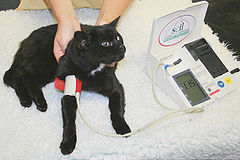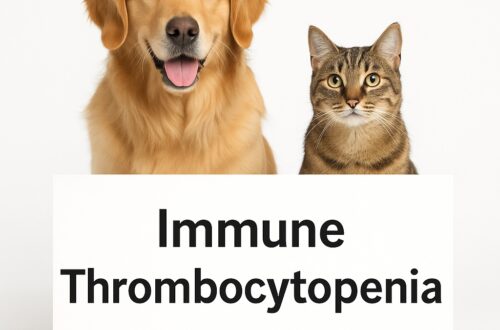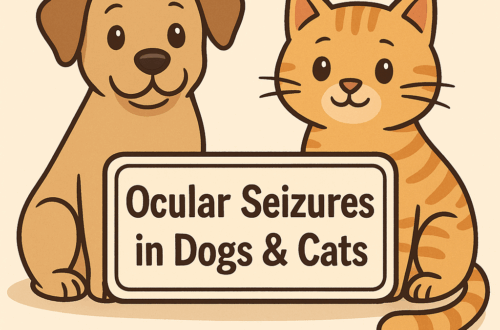Vital signs (i.e.: heart rate, respiratory rate and body temperature) are non-invasive clinical measurements used to assess the state of a patient’s essential body functions. Clinical board-certified veterinary specialists consider blood pressure (BP) to be the fourth vital sign, but sadly the prevalence of appropriate blood pressure monitoring in veterinary medicine is low compared to that in human medicine despite ample documentation of its importance. Indeed some veterinary hospitals don’t even have the capability of measuring blood pressure despite caring for patients at risk for blood pressure problems.
What is blood pressure?
Blood pressure is the product of the volume of blood pumped by the heart in one minute (called cardiac output or CO) and the resistance against which the left side of the heart must overcome to pump blood to vital organs (called systemic vascular resistance or SVR). This relationship is described with the following equation:
BP = CO x SVR
Many factors influence both CO and SVR, and thus positively or negatively affect BP.
How is blood pressure measured?
Blood pressure can be measured via two general methods: direct measurement and indirect measurement.
Direct measurement:
To directly measure blood pressure, a veterinarian must place a catheter directly into an artery in a leg. The catheter is then connected to a specialized monitor that provides a blood pressure measurement. Direct blood pressure monitoring is not routinely performed in primary care practice, but is quite common in intensive care units.

Indirect measurement:
Blood pressure is most commonly measured indirectly in dogs and cats by placing a special cuff around a limb over an artery. The two indirect monitoring methods are the use of a Doppler machine and the use of an oscillometer.
Doppler

Oscillometer

Anesthesia and blood pressure monitoring
Dogs and cats will inevitably require anesthesia at some point in their lives – to be neutered or spayed, to have a laceration repaired, and/or to have a skin growth removed. Anesthetic drugs affect major organ systems, particularly the brain, heart, lungs, kidneys and liver. One of the most common potential adverse effects of anesthesia is low blood pressure (hypotension), and hypotension causes decreased oxygen delivery to vitals organs, potentially causing significant and potentially life-threatening dysfunction.
Clinical board-certified veterinary specialists recommend monitoring blood pressure during anesthesia.
I strongly encourage pet parents make sure their pet’s blood pressure is appropriately monitored during any procedure for which anesthesia is needed.
Blood pressure monitoring with specific diseases
There are several diseases with which dogs and cats may be diagnosed that may cause blood pressure changes, most commonly elevated blood pressure (hypertension). Appropriate monitoring and therapy is absolutely essential for helping slow disease progression and prevent adverse outcomes. Some common diseases associated with blood pressure abnormalities include:
Chronic kidney disease (CKD):
Chronic blood pressure is a significant concern for patients living with chronic kidney disease because the increased pressure produces injury to various tissues (called target-organ damage). The kidneys themselves are target organs affected by hypertension, and high blood pressure in patients with CKD is associated with faster rate of decline of kidney function, amplified leakage of protein in the urine, and increased mortality.
Heart diseases:
Several types of heart diseases, including heart muscle disorders (cardiomyopathies) and heart valve leakage disorders (atrioventricular insufficiency), may be associated with either high or low blood pressure. Exquisite blood pressure monitoring and appropriate subsequent therapies to address derangements are essential for maximizing the likelihood of a positive outcome.
Hyperthyroidism:
Excess production of thyroid hormone is a relatively common disease in older cats, and the prevalence of hypertension in this patient population ranges from 9% to 23%. Furthermore approximately 20% of cats treated for hyperthyroidism will develop hypertension, but the mechanism for the formation of this derangement remains unclear at this time. Sometimes the blood pressure elevation can be so severe that affected cats become acutely blind from bleeding in the back of the eye (retinal hemorrhage) and/or retinal detachment. Click here to learn more about hyperthyroidism in cats.
Hyperadrenocorticism (Cushing’s disease):
Cushing’s disease is a relatively common hormone disorder in dogs characterized by chronic elevations of the body’s own steroid called cortisol. Patients with untreated Cushing’s disease often have hypertension with a documented prevalence of 37% to 86%. The mechanism responsible for inducing high blood pressure in these patients is multifactorial, and appropriate control of hypertension is of paramount importance to prevent target-organ damage. Click here learn more about Cushing’s disease!
The take-away message…
Measuring blood pressure should be considered the fourth vital sign given its profound importance in so many ailments, including chronic kidney disease and heart disorders. Patients placed under anesthesia should have their blood pressure monitored closely to help prevent target-organ damage. I strongly encourage pet parents to speak with their fur baby’s primary care doctor about appropriate blood pressure monitoring, and they may find some benefit in consulting with a board-certified veterinary specialist about this topic.
To find a board-certified veterinary internal medicine specialist, please visit the American College of Veterinary Internal Medicine.
To find a board-certified veterinary emergency and critical care specialist, please visit the American College of Veterinary Emergency and Critical Care.
Wishing you wet-nosed kisses,
cgb




